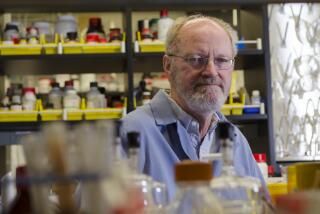Chemist studied reactions in cells
Jeremy R. Knowles, the Harvard chemist who played a key role in explaining how chemical reactions are carried out within the cell and who later became dean of the university’s faculty of arts and sciences at a time when it was bloated with faculty and drowning in debt, died April 3 at his home in Cambridge, Mass.
He was 72 and had struggled for more than a year with prostate cancer.
“Jeremy’s leadership, intellect and courage have been an inspiration to us all,” said the current dean, computer scientist Michael D. Smith. He guided the faculty of arts and sciences “with an unwavering dedication to the highest standards of academic excellence and to the university’s highest ideals. His leadership strengthened the FAS immeasurably.”
As a graduate student in physical chemistry, Knowles said, he was fascinated trying to understand “why some reactions went 10 times as fast as others.” During a postdoctoral fellowship at Caltech, he encountered reactions catalyzed by the enzyme chymotrypsin that went a million times faster than unaided reactions.
With characteristic modesty, he later said he remembered thinking, “Here I am, struggling -- and failing -- to understand a factor of 10. Would it not be perhaps more important to fail to understand something big than to fail to understand something small?”
Over a 30-year career studying enzymes at Oxford University and Harvard, Knowles used the methods of chemistry to answer biological questions, such as determining the molecular basis for how we digest our food, how bacteria become resistant to penicillin antibiotics and how our bodies use energy.
He also studied evolution at the molecular level, mapping the steps that, over 4 billion years, have brought enzymes -- the proteins that carry out chemical reactions within cells -- to such formidable efficiency.
In the course of defining how enzymes work, he introduced the idea of “catalytic perfection” to illustrate the effectiveness of these molecules. His research showed that, in many cases, enzymes are perfect. It would be theoretically impossible, he showed, to design an enzyme to increase the overall chemical reaction rate any further.
As catalysts, the enzymes have reached the end of their evolutionary development.
In 1983, while Knowles was chairman of Harvard’s chemistry department, he was recruited to become dean of the faculty. He refused, saying that at 48 he was too young and that he still had work to do in the lab.
But when the offer was extended again eight years later, he accepted, becoming the overseer of a faculty with 600 members, an annual budget of $500 million and an annual deficit of $12 million.
Over the next six years, he eliminated the deficit by refusing new appointments, vetoing expensive projects and allowing the staff to shrink by attrition. The number of faculty fell by 10% over the period.
While he was getting the faculty on an even financial keel, he began a series of initiatives that included uniting 17 departments in the humanities, constructing several new buildings, instituting greater financial aid for students, and launching centers for genomics, imaging, nano-scale structures and a center for brain science.
He also increased the number of senior faculty and more than doubled the number of women on the faculty.
Jeremy Randall Knowles was born April 28, 1935, the son and grandson of Oxford professors.
After graduating from high school, he joined the Royal Air Force as a pilot officer but was ineligible to fly because he was slightly nearsighted.
As a radar controller, the teenager took over for another controller who had lost his nerve during a war games exercise, inheriting eight jets low on fuel. He managed to save all eight pilots and seven of the planes.
After completing his service, he returned to Oxford, receiving his bachelor’s, master’s and doctoral degrees in chemistry.
He played the piano and sang in choruses, which is where he met his wife, the former Jane Sheldon Davis, whom he married in 1960. “He had tremendous vitality and he was a great dancer,” she later said.
Throughout his career, his colleagues characterized him as “disciplined,” “driven” and “highly reasoned.” Many attributed his success as dean to his ability to say no to frequent requests, an ability that he attributed to his early service in the military.
Knowles wrote more than 250 research papers and received awards that included the Charmian Medal, the Bader Award, the Repligen Award, the Prelog Medal, the Robert A. Welch Award in Chemistry and the Davy Medal of the Royal Society. He was appointed a Commander of the Order of the British Empire in 1993.
In addition to his wife, Knowles is survived by three sons, Sebastian of Columbus, Ohio, Timothy of Chicago and Julius of Weston, Mass.; and seven grandchildren.
--





